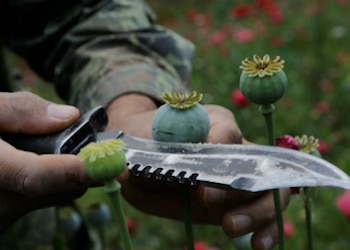A new documentary series exploring the opioid epidemic ravaging cities across the United States underscores the role of Mexican organized crime groups in the lucrative industry, and how growing demand is fueling production, and violence, south of the border.
The series, produced by Showtime and titled “The Trade,” travels from the heart of poppy fields in Mexico’s southwestern Guerrero state to small towns in middle America to examine the different layers of the US opioid epidemic. The series follows three central storylines: poppy cultivators and heroin traffickers in Mexico, heroin users and their families across the United States, and US and Mexican law enforcement officials trying to thwart the growing crisis.
The series opens up to several workers cultivating poppy deep in Guerrero’s rollings hills within Mexico’s so-called Golden Triangle, a key drug production region and the country’s epicenter for poppy production. Poppy cultivation is the primary source of sustenance for those living in this region. As one cultivator put it, “You could grow something else like corn, but you’d barely feed yourself.”
SEE ALSO: Coverage of Heroin
A man who they call “Don Miguel,” the leader of a local drug trafficking group, is the primary focus of the series in Guerrero. Amid trying to successfully cultivate his poppy crops and move the processed heroin north, Don Miguel faces constant threats from a rival group, identified as Los Rojos. In addition to the regular offensives, Don Miguel must also fend off the eradication efforts of Mexican security forces.
Later in the series, traffickers boast about their heroin being the “best there is” and the “countless” ways they can successfully smuggle the drug through the border — strapped to their bodies or in cars and motorcycles, among other ways — for sale in the United States at four to five times the market value in Mexico. US officials on the border in El Paso, Texas, admit they are only able to divert eight to ten percent of the more than 30,000 vehicles that pass through their checkpoint per day.
After the drugs arrive in the United States, the series explores how in some cases, Mexican nationals living in small towns in Ohio are in contact with drug cartels in Mexico in order to lead heroin distribution networks on their behalf. Small towns in middle-American states like Ohio are gateways to larger US cities on the East Coast.
The series leads to a depressing conclusion. Mexico’s Counter-Drug Division Police Commander Juan Carlos Silva admits that, despite security forces’ efforts, heroin production will undoubtedly continue.
And as one drug trafficker puts it, “The Mexican federales and American police, they are fighting a very large enemy called money, and against that, no one can win.”
InSight Crime Analysis
The timing of the documentary is propitious. Heroin use is at epidemic levels in the United States; violence in Mexico broke records in 2017.
According to Myles Estey, one of the show’s producers, if the “demand for heroin remains insatiable,” criminal groups in Mexico will continue to go to great lengths to control the territory needed to meet that demand.
“From everyone we spoke to on the ground in Mexico, all signs point to increasing the yield to keep up with this insatiable demand,” Estey told InSight Crime in an email.
“Criminal groups in Mexico can control every step of heroin production, from planting the seeds to processing the poppy gum, shipping processed heroin north [and] sending it across the border,” he said. “This means profits across the supply board, and a race to both harvest more poppy and control more territory.”
Guerrero is now the United States’ biggest heroin supplier, which has in part contributed to extremely high levels of violence in that state. As Mexico’s criminal landscape grows increasingly more fragmented, criminal groups are waging a bloody war against each other to capitalize on the lucrative trade. The 3,108 homicides recorded in Guerrero in 2017 made it Mexico’s third most violent state.
SEE ALSO: Mexico News and Profiles
Moreover, Estey explained how the increasing poppy eradication campaigns from Mexican security forces don’t seem to be having any “real impact on the resolve of the growing communities.”
“If anything, the raids just create more motivation to plant more crops in order to keep up with demand,” Estey told InSight Crime. “As long as a consistent buyer exists, people will take economic and personal risks to grow, cook, traffic and distribute heroin.”
But according to Estey, US demand is not the only thing driving locals in Guerrero towards the highly profitable heroin trade, and it’s going to a take a multi-faceted approach from Mexican officials to curb production.
“Guerrero hovers among the poorest of Mexico’s 31 states, and many residents believe the government fails to create opportunity for gainful employment,” Estey told InSight Crime. “Without working to curb some of the root causes, it will continue to be a breeding ground for some of Mexico’s most profitable drug trafficking and the horrific related violence.”
“The Trade” premieres on Showtime Friday, February 2, 2018 at 9:00pm EST

